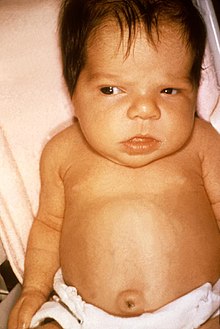Congenital hypothyroidism
| Congenital hypothyroidism | |
|---|---|
 | |
| 6 week old female with jaundice due to hypothyroidism. | |
| Specialty | Endocrinology |
Congenital hypothyroidism (CH) is
Causes of congenital hypothyroidism include iodine deficiency and a developmental defect in the
Treatment consists of a daily dose of thyroid hormone (
Signs and symptoms
Infants born with congenital hypothyroidism may show no effects, or may display mild effects that often go unrecognized as a problem:
In the era before newborn screening, less than half of cases of severe hypothyroidism were recognized in the first month of life. As the months proceeded, these babies would grow poorly and be delayed in their development. By several years of age, they would display the recognizable facial and body features of cretinism. Persistence of severe, untreated hypothyroidism resulted in severe mental impairment, with an
-
3-month-old infant with untreated CH; picture demonstrates hypotonic posture, myxedematous facies, macroglossia, and umbilical hernia
-
Close up of face, showing myxedematous facies, macroglossia, and skin mottling
-
Close up showing abdominal distension and umbilical hernia.
-
Congenital hypothyroidism, copper engraving, 1815
Cause
Around the world, the most common cause of congenital hypothyroidism is
In some instances, hypothyroidism detected by screening may be transient. One common cause of this is the presence of maternal antibodies that temporarily impair thyroid function for several weeks.[5]
The word "cretinism" is an old term for the state of mental and physical retardation resulting from untreated congenital hypothyroidism, usually due to iodine deficiency from birth because of low iodine levels in the soil and local food sources. The term, like so many other 19th century medical terms, acquired pejorative connotations as it became used in lay speech. It is now deprecated; ICD-10 uses "congenital iodine deficiency syndrome" with additional specifiers for the various types.[citation needed]
Genetics
Congenital hypothyroidism can also occur due to genetic defects of thyroxine or triiodothyronine synthesis within a structurally normal gland. Among specific defects are thyrotropin (TSH) resistance, iodine trapping defect, organification defect, thyroglobulin, and iodotyrosine deiodinase deficiency. In a small proportion of cases of congenital hypothyroidism, the defect is due to a deficiency of thyroid-stimulating hormone, either isolated or as part of congenital hypopituitarism.[6] Genetic types of nongoitrous congenital hypothyroidism include:
OMIM
|
Name | Gene |
|---|---|---|
| 275200 | congenital hypothyroidism, nongoitrous 1 CHNG1 | TSHR
|
| 218700 | CHNG2 | PAX8 |
| 609893 | CHNG3 | ? at 15q25.3-q26.1 |
| 275100 | CHNG4 | TSHB |
| 225250 | CHNG5 | NKX2-5
|
Nongoitrous congenital hypothyroidism has been described as the "most prevalent inborn endocrine disorder".[7]
Diagnosis
In the developed world, nearly all cases of congenital hypothyroidism are detected by the newborn screening program. These are based on measurement of TSH or thyroxine (T4) on the second or third day of life (Heel prick).[1]
Evaluation
If the TSH is high, or the T4 low, the infant's doctor and parents are called and a referral to a
Treatment
The goal of newborn screening programs is to detect and start treatment within the first 1–2 weeks of life. Treatment consists of a daily dose of
Prognosis
Most children born with congenital hypothyroidism and correctly treated with thyroxine grow and develop normally in all respects. Even most of those with athyreosis and undetectable T4 levels at birth develop with normal intelligence, although as a population academic performance tends to be below that of siblings and mild learning problems occur in some.[9]
Congenital hypothyroidism is the most common preventable cause of intellectual disability. Few treatments in the practice of medicine provide as large a benefit for as small an effort. The developmental quotient (DQ, as per Gesell Developmental Schedules) of children with hypothyroidism at age 24 months that have received treatment within the first 3 weeks of birth is summarised below:[citation needed]
| . | Adaptive behavior | Fine motor | Gross motor | Language | Personal-social behavior |
|---|---|---|---|---|---|
| Severe CH | 92 | 89 | 90 | 89 | 90 |
| Moderate CH | 97 | 97 | 98 | 96 | 96 |
| Mild CH | 100 | 99 | 100 | 99 | 100 |
Epidemiology
Congenital hypothyroidism (CH) occurs in 1:1300 to 1:4000 births worldwide.
References
- ^ a b c "Hypothyroidism". The Lecturio Medical Concept Library. Retrieved 27 July 2021.
- ^ S2CID 208039220.
- PMID 17307219.
- S2CID 24175902.
- ^ "Congenital hypothyroidism". Orphanet. August 2010. Retrieved 22 May 2012.
- ^ "Hypopituitarism". The Lecturio Medical Concept Library. Retrieved 27 July 2021.
- S2CID 19782628.
- S2CID 638254.
- PMID 8062543.
- PMID 21467693.
- ^ PMID 9439909.
- PMID 17512233.
- PMID 17504897.[permanent dead link]
- PMID 20435715.
- ^ PMID 16322381.




